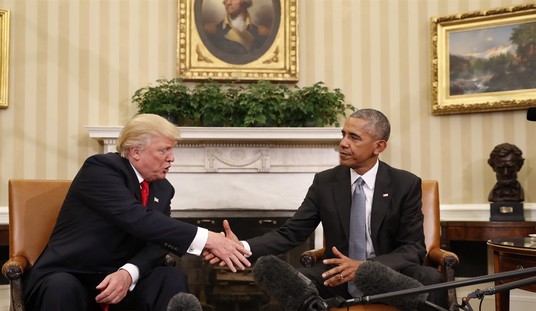President Obama has promised to reveal some details of ObamaCare II today. It will be different in some respects from ObamaCare I, which more Americans now oppose than support. Which is cool, and I enjoyed this cartoon. In the meantime, I have a few modest suggestions. None were a part of ObamaCare I, and I am willing to bet that none will be included in the new draft.
My wife and I have lived in Panamá for about seven years. Health care is good and inexpensive; it is not perfect, and problems exist due to the topography and population distribution in Panamá as well as the limited funds available. The population of Panamá is about three and a half million, and there are many rural areas, some of them very remote.
I. “Free” health care for all
Here, there is “free” health care for all full-time employees and their immediate families, including a spouse and unmarried minor children. They and their employers pay for it through the social security system. Health care is provided during their working years as well as after retirement, when they also receive modest retirement payments.
All full-time employees are required by law to participate and to pay approximately 9.2 percent of their salary in social security fees; their employers are required to pay approximately 15.96 percent of salary. The amount which our one full-time employee pays, and which we pay on his behalf, totals $52.21 per month — only part of which goes for health care. People who are self-employed are not automatically covered by the social security system, but they can be by paying a modest amount into the system.
The system gives beneficiaries and their immediate families access without further charge to medical care at local health clinics and, if appropriate, at social security hospitals. The smallest clinics are staffed by nurses with a physician on call. The larger ones are staffed by physicians as well as nurses. Even in the rural area where we live, frequent bus service is available within a ten-minute walk. It takes the bus another ten minutes to reach the nearest clinic, located in a small village (population 1,165). An ambulance is available if necessary. The clinic provides immediate care and triage. If necessary treatment is not available there, the patient is transported, by ambulance if appropriate, to a facility with the equipment and personnel to deal with the problem. Sometimes this means transport to the social security hospital in the city of David (population 124,500), roughly twenty-five miles away. Rarely, it requires transport to the principal social security hospital in the city of Panamá (population 708,738), roughly two hundred and fifty miles away.
Medical care at the social security hospitals is good, but the families or friends of patients are expected to do their part by bringing food, changing bed linens, and doing other things of that sort normally done by hospital staff at private hospitals. This is a cultural thing — since extended families are common here, it is not a significant problem and obviously saves money.
A slightly modified program in the United States would take tremendous pressure off the expensive emergency rooms in hospitals full of costly equipment and with specialists immediately available or on call. It would also greatly diminish the waiting time for patients who actually need immediate emergency care. I have no idea how much money would be saved, but I believe it would be substantial.
Some medications are also provided, without charge, by the social security clinics and hospitals. Some are not available there and have to be purchased. However, most medicine available in the United States is also available in Panamá, at far less cost. One medication I have occasionally used for many years now costs in excess of $100.00 in the United States. The identical medication costs less than $10.00 here. All elderly citizens (women over fifty-five and men over sixty), as well as elderly non-citizens with legal permanent resident status, are required by law to be given substantial discounts on any medical services and prescription medications for which they pay, as well as on various other things.
II. Inexpensive health care for everyone else
The same care provided to social security beneficiaries is available to everyone else at minimal cost. For example, a routine doctor visit at a social security clinic costs $3.00. An elderly (mid-eighties) uninsured Canadian friend was diagnosed a few years ago with cancer; he required a month of outpatient chemotherapy. His total costs, including transportation to and from Panamá City, a modest hotel room, food, taxis, daily visits to the oncology hospital, and all other associated costs totaled less than $1,600. That is not a typographical error. He recovered and leads a normal and productive life running a small business. I required surgery a few days ago to remove and biopsy some suspicious lesions on my head and forehead. The surgeon, whose English is excellent, works at a small but quite adequate hospital in nearby David associated with neither the social security system nor with our health insurance company. The surgery was done under a general anesthetic and took just over an hour. Following surgery, I spent about two hours in bed at the hospital to recover. The total cost for everything including the biopsy was $450.
Private health insurance is available here at reasonable cost. In Washington, D.C., I paid over $1,000 per month in the late 1990s. We pay less than one-tenth of that here. That includes cancer coverage for my wife; since I had cancer surgery and radiation therapy in the United States in 1998, I am not eligible for cancer coverage here. I am sixty-eight years old, and my wife will soon be sixty-five. The rates increase slightly as one ages.
III. Factors which keep costs low
One factor which helps to keep medical costs (and therefore health insurance premiums) to a minimum is that very few medical malpractice suits are brought — litigiousness is not a Panamanian thing. Hence, physicians and other medical personnel are not burdened with obscene malpractice insurance premiums and trial lawyers do not get rich by bringing or threatening malpractice suits. This also reduces the incidence of defensive medicine, necessary to obviate many malpractice claims but unnecessary for the well-being of patients. The tests deemed medically (rather than legally) necessary are done — inexpensively and quickly.
An excellent surgeon who operated on me for cancer in the United States in 1998 later ceased the practice of medicine and became an attorney specializing in medical malpractice litigation. He will not take a case unless his medical background leads him to conclude that the claim is meritorious and his experience as an attorney leads him to expect that it will generate legal fees of at least $100,000. No matter how meritorious the case may be, he is very unlikely to take it in a jurisdiction where jury awards are low. With reasonable caps in all jurisdictions, some malpractice attorneys in high jury award states might need to find another specialty or move to another jurisdiction with more victims.
The trial lawyers’ associations, which traditionally support Democratic Party proposals, oppose such caps and that is one of the reasons why ObamaCare does not call for them. In an unusually candid statement, Howard Dean said:
The reason tort reform is not in the [health care] bill is because the people who wrote it did not want to take on the trial lawyers in addition to everybody else they were taking on. And that’s the plain and simple truth.
In 2003, Texas imposed substantial caps on medical malpractice awards, and the resulting influx of physicians from jurisdictions lacking such caps was surprisingly great. The United States should give serious consideration to placing reasonable caps on medical malpractice recoveries. As a recovering attorney, I have nothing against lawyers earning a good living. However, there are less socially harmful ways to do it.
IV. Personal experiences
I have had several experiences here with insurance-covered medical care, all of them good. Four years ago, I awoke with two large welts on my forehead. Spider bites had caused an allergic reaction. I became both weak and disoriented. My wife drove me to the emergency room at Hospital Chiriquí in David.
There was no crowd of sick or injured people and I was seen immediately. A nurse promptly contacted the on-call physician, began limited treatment, and got lab tests and an IV drip started. The on-call physician arrived quickly, examined me, and after reviewing the various lab results added something to the IV drip. The entire experience was successful and lasted roughly three hours. I paid only $33.00 — that’s not a typo either. The balance (I did not bother to find out how much, but I suspect it was about $60.00) was covered by our medical insurance.
Two years ago, a spinal compression caused my left leg to cease to function properly. I went to a highly regarded (and properly so) neurosurgeon at Hospital Chiriquí. It was after 6:00 p.m., so following an hour-long examination he telephoned the head of the insurance company at home and received immediate authorization for an emergency MRI. I had the MRI the next morning and had surgery the following day.
The surgery took over five hours, and I was hospitalized for four days following surgery. While hospitalized, I received physical therapy to help restore leg function, lots of medication, frequent visits from my physician, etc. The food, by the way, was excellent, although the filet mignon was a tad overdone for my tastes. The nursing staff appeared to be more numerous than the patients in the post-operation rooms; all were extremely attentive and seemed to know what they were doing.
The total cost for everything was approximately $14,000. The insurance company paid half, and I paid half. Checking into the hospital took all of ten minutes. About a week after the surgery (I had been advised not to drive for a while), the neurosurgeon drove to our home (about 35 minutes by car) one evening to check on me and to deliver various medications, some related to the surgery and some I needed for other reasons. Follow-up visits to the neurosurgeon at his office were included in the cost of the surgery.
Immediately following my surgery, and on other occasions, he told me to telephone him any time I felt the need to do so. His business card, as is customary here, includes his office phone number, his home phone number, and his cell phone number.
Our maximum insurance coverage per year is only $15,000 per person (not including my wife’s cancer coverage, which has a substantially higher cap) — a mere pittance in the United States. Here, it seems entirely adequate.
V. Deficiencies
Some cutting edge medical care available in the United States is not available here. I do not think that some organ transplants, for example, are available. Since we no longer live in the United States, we have no medical insurance there. Should I require very expensive treatment not available inPanamá, I would most likely do without it and rely on whatever palliative care might be available. Were that to mean my death, so be it. We all die, and I have no interest in postponing the inevitable for a few months of intensive, invasive, unpleasant, and expensive treatment. I cherish the freedom to make that sort of decision myself and don’t think that anyone else — particularly the government — should have the power to make it for me.
For most people, even those who live in far more remote rural areas than we do, it is possible to get to a social security clinic. Relatively few cannot do so. If bitten by a highly venomous snake, the chances of death are substantial. The same is likely true in comparable areas of the United States. “Rich” people can get better medical care than very poor people. That is also true in the United States. Nevertheless, I think the care provided even to the very poor here is generally better than that available to them in the United States.
VI. Dreams
The very best cutting edge medical care free for everyone, with no waiting and the right to sue for enormous damages should something go wrong, might be nice. It would also be great if everyone could live in luxurious homes maintained by loyal servants, have enjoyable high-paying jobs with three months paid vacation per year, and not have to worry about gasoline costs or mortgages. Discovery of the Fountain of Youth, with whatever miraculous substances it might contain available free for everyone, might also be good.
The problem, obviously, is that many of these dreams are impossible. As to the others, somebody would have to pay through the nose. Our “friends” in China are already becoming upset about financing the current lifestyle in the United States. According to the Obama administration, federal borrowing will account for 39.9 percent of expenditures during the fiscal year beginning in September; personal income tax returns will amount to 27.3 percent.
The government will be borrowing the largest share of federal spending since World War II, when the federal government borrowed 62 percent of the budget in 1943.
The estimated national deficit for the next ten years is already over nine trillion dollars, more than the sum of all deficits since America’s founding. By the next decade’s end, it is estimated that the “the national debt will equal three-quarters of the entire U.S. economy.” In these circumstances, China and other countries seem quite likely to do less rather than more to help perpetuate our lifestyle — they may even own us.
Many here think that Americans have a four-part mentality: 1) I like it, 2) so I want it, 3) so I need it, 4) so I am entitled to it. That may be an exaggeration, but is not too far off the mark. Use of ObamaCare (whatever that might be) to perpetuate this conception in the United States and abroad would be delusional and foolish.









Join the conversation as a VIP Member